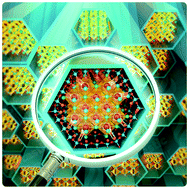Improvement in the stability of γ-CsPbI3 nanowires enabled by lattice immobilization through the Pb–O anchor in SBA-15†‡
Abstract
Inorganic black-phase CsPbI3 perovskites (cubic α, tetragonal β and orthorhombic γ) have attracted immense attention due to their superior optical and optoelectronic properties. However, the black phase is metastable and spontaneously transforms into a non-optically active yellow phase (orthorhombic δ) as the temperature drops to room temperature or even lower. This severely inhibits its practical applications under light and driving voltage, and at varying temperatures. Here, we report a novel method to improve the stability of γ-CsPbI3 nanowires in a wide temperature range. With an ordered mesoporous silica SBA-15 template, the CsPbI3 nanowires are confined into the channels and crystalize in the δ phase, which can transform into the γ phase under calcination at 623 K. Compared with the CsPbI3 obtained without SBA-15, these γ-CsPbI3 nanowires are stable until 193 K, the lowest temperature record to date. The phase stability stems from the interfacial coordination of Pb and O, which acts as an “anchor” to suppress the distortion of the [PbI6]4− octahedron for γ-CsPbI3. Additionally, this protocol can be extended to mixed halide perovskites. The “anchor” in this work is also expected to shed light on intriguing studies on the phase stabilization of other functional materials.

- This article is part of the themed collections: 2020 Inorganic Chemistry Frontiers HOT articles and Celebrating 110th Anniversary of Chemistry at Peking University


 Please wait while we load your content...
Please wait while we load your content...